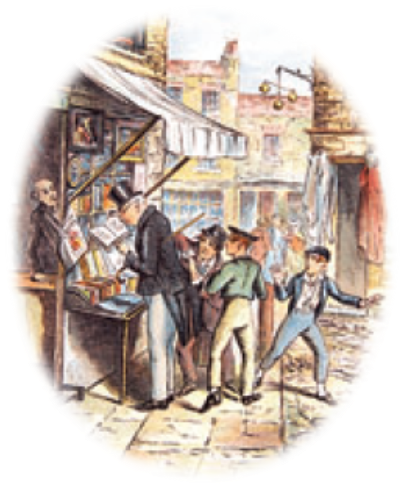 |
|
The Novel Comes of Age
 The Victorian period (1832–1901) is often called the age of the novel. The Victorian era ushered in the focus on realistic depictions of life that continues to this day. Victorian novels are known for their realism—the detailed presentation of everyday life. Through the novel, Victorian writers wanted to document the lives and the values of the English, including the lower classes. As the Victorian era continued, social concerns began playing a greater role in the general society, and the novel became a tool for exposing society’s ills. No other writer used this tool as effectively as did Charles Dickens. His novels Oliver Twist (1837–1839), A Christmas Carol (1843), David Copperfield (1849–1850), and Bleak House (1852–1853), described in riveting detail the troubling state of England’s lower classes.
The Victorian period (1832–1901) is often called the age of the novel. The Victorian era ushered in the focus on realistic depictions of life that continues to this day. Victorian novels are known for their realism—the detailed presentation of everyday life. Through the novel, Victorian writers wanted to document the lives and the values of the English, including the lower classes. As the Victorian era continued, social concerns began playing a greater role in the general society, and the novel became a tool for exposing society’s ills. No other writer used this tool as effectively as did Charles Dickens. His novels Oliver Twist (1837–1839), A Christmas Carol (1843), David Copperfield (1849–1850), and Bleak House (1852–1853), described in riveting detail the troubling state of England’s lower classes.
New Forms Emerge
In the 19th c., a remarkable variety of English novels were written, giving rise to several popular new subgenres:
• Historical novels—In this type of novel, historical facts are combined with the fictional elements to re-create the spirit of a past age. Charles Dickens based A Tale of Two Cities (1859) on historical accounts of the French Revolution.
• Gothic novels—Horror tales became extremely popular in England near the turn of the 19th c. Frankenstein (1818) by Mary Shelley is the best known example of gothic fiction.
• Detective novels—Mystery is a major ingredient of detective fiction. Sir Arthur Conan Doyle mastered this form in the late 1800s and created Sherlock Holmes, still the world’s most famous detective.
• Newgate novels—Stories focusing on criminals and their motives attracted a growing audience. Newgate fiction—named after a famous London prison—explored the nature of crime and violence. An example is Charles Dickens’s Barnaby Rudge (1841), which looks at the effects of civil unrest and riot.
After 1880, realism spawned several other schools of literary writing, including psychological realism and naturalism. In France, naturalismpromoted a grimmer, more “scientific” approach to fiction. Naturalistic writing was an attempt to depict the human condition as objectively as scientific writings depicted the processes of nature. An example is Tess of the D’Urbervilles (1891), in which Thomas Hardy portrayed a hostile world where only the “fittest” prospered.
• Social-problem novels, also called “Condition of England” novels, drew attention to social ills in an attempt to spark reform. For instance, Dickens’s novels Hard Times and Oliver Twist reveal the poverty and exploitation of London’s lower classes, and his novel Bleak House focuses on the corruption in England’s legal system. Elizabeth Gaskell also wrote several novels urging social reform. Her first novel, Mary Barton, depicts the harsh, miserable conditions of the working-class people. In the preface to the work, Gaskell wrote, “Whatever public effort can do in the way of legislation, or private effort in the way of merciful deeds ... should be done, and that speedily.” Social-problem novelists opposed blind faith in progress, and by presenting a realistic account of the negative effects of the Industrial Revolution, they raised public consciousness and triggered social reforms.
• Regionalist novels employ a detailed setting that is often modeled on an actual, usually rural, location. Regionalist novels are examples of Realism in the sense that they emphasize accurate rather than romantic settings and explore how place influences characters and events. This type of fiction is further characterized by the use of local dialect, references to natural or physical landmarks, incorporation of the community’s political or social values, and parody of local characters. For example, Thomas Hardy set all of his novels in the fictional county of Wessex, which was based on the county of Dorset and the town of Dorchester. Charlotte and Emily Bronte both created haunting backdrops in Jane Eyre and Wuthering Heights that echo the Yorkshire moors where they grew up. Nineteenth-century publishing trends, such as the serial novel, may not remain popular today, but their enduring impact was the firm establishment of a public market for literature. Toward the end of the 19th c., free public libraries began to replace subscription libraries, ensuring that literature would remain widely available.